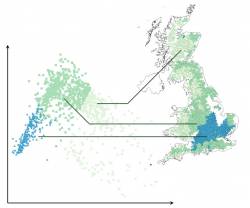Table of Contents
Asymptotics for intermodel comparisons of flood-estimation models

One of the key problems in flood estimation is to predict the flow in the river after an intensive rainfall. Hydrologists use a variety of methods for such predictions, ranging from physical (PDE) to conceptual to statistical models. These models are often based on different assumptions; such assumptions may be subtle and hidden, and perhaps contradictory.
Here, we describe some of the recent work (in collaboration with Dr. Piotr Morawiecki) to develop a rigorous mathematical framework in order to better understand the relations between different classes of models. We develop simple benchmark scenarios for coupled surface-subsurface flows. Extensive data analysis of UK catchments allowed us to estimate key non-dimensional quantities affecting the flow. The subsequent study of these models using asymptotic analysis allows us to compare their behaviours in certain limiting scenarios and extract key factors affecting the formation of peak river flows.
This intercomparison of asymptotic behaviour of different classes of models can be used as a complementary tool to computational methods for assessing flood model accuracy, and can be used to better understand their applicability limits.
Below you can find links to articles and videos summarising major part of the research project.
Development and analysis of coupled surface-subsurface models
The main part of the initial stage of research was summarised in a three-part article “On the development and analysis of coupled surface-subsurface models of catchments”
In Part 1 we estimated the typical size of physical catchment parameters characterising UK catchments. In Part 2 we formulated a simple 3D catchment benchmark model and used estimates from Part 1 to show that the model can be reduced to a 2D form. Finally, in Part 3 we showed that in the case of overland-dominated catchments, the 2D model can be further reduced to 1D form and found its approximated solution. The analytical hydrograph obtained can be used in future studies to understand limitations of other rainfall-runoff models.
To appear in the Journal of Fluid Mechanics (2024).
Asymptotics of conceptual models (PDM) and their relations to physical models
(In Review)


